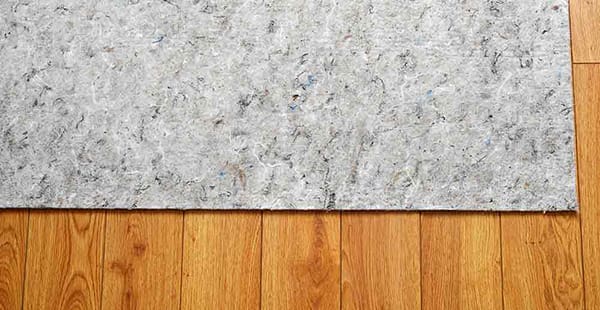Why Was Asbestos Used in Felt?
Asbestos was used in felt products to provide heat resistance and durability. Companies commonly used this felt to make asbestos paper for roofing and flooring.
Felt is produced by matting and pressing fibers together to form a dense, flexible material. Heavy-duty felt was often used in construction to provide extra insulation and protection. Asbestos in flooring and roofing materials was popular from the early 1900s to the early 1990s.
Asbestos Felt History at a Glance
- Other Names: Asbestos padding, asbestos paper backing, black roofing paper, coated base sheet, cold-process roofing, dryer felt, underlayment, vapor barriers
- Years of Manufacture: Early 1900s – Early 1990s
- Military Use: Barracks, general facilities, housing
- Places Used: Businesses, homes, paper mills
- Asbestos Use Banned: Partial ban
- Noteworthy Brands: Bird Corporation, Congoleum, Johns-Manville, Pittsburgh Corning
Asbestos felt was manufactured in various forms for much of the 20th century. Asbestos regulations in the 1970s began to curb use. By the mid-1980s, asbestos was discontinued in most flooring and roofing products. But asbestos felt materials may still be in older buildings.
There is no comprehensive asbestos ban in the United States. The Environmental Protection Agency (EPA) has banned or restricted many asbestos products. The EPA’s 1989 asbestos rule banned the use of asbestos flooring felt, among other products.
Often, asbestos felt was used as an underlayment for floors and roofs. Underlayment provides cushion, insulation and another layer of protection.
Many companies made asbestos felt products, which fell into several primary categories:
- Asbestos carpet padding
- Asbestos linoleum flooring
- Asbestos paper for flooring
- Asbestos roofing shingles
- Asbestos roofing underlayments
- Asbestos vinyl sheet flooring
In some instances, both the felt underlayment and the surface material contained asbestos. For example, asbestos floor tiles and asbestos roofing shingles were both common in buildings. These products may have also had asbestos paper backings.
Dangers of Asbestos in Felt
Research has highlighted the risk of exposure from asbestos felt. In one study, scientists sanded asbestos roofing felt in a controlled environment. Then, they measured asbestos dust levels in the air. They found 33% of the air samples contained chrysotile asbestos fibers. In uncontrolled environments, workers using asbestos felt products face risks of inhaling or ingesting these fibers.
Many renovation activities performed on asbestos felt, like grinding or sawing, pose asbestos exposure risks. Asbestos exposure may lead to mesothelioma and other diseases.
Consistent and elevated levels of exposure are more likely to have long-term effects. But any level of asbestos exposure can lead to serious health issues.
List of Asbestos Felt Products
Asbestos felt was used in various ways for roofing and flooring. For instance, it was added as a paper backing for roof shingles. It also served as carpet padding and vinyl floor lining. Many popular asbestos felt products can be recognized by their brand names.
Click below to see asbestos felt products made by notable companies:
Many asbestos companies manufactured, sold and installed asbestos felt products. Some of these companies may also have produced other asbestos products.
One of the first roofing products to use asbestos felt was Bird Corporation’s asphalt roofing. This was developed in the late 1800s. The product’s dense felt contained asbestos fibers and was coated with mineral grit. Various sizes and weights were manufactured for nearly a century.
Below are examples of large manufacturers. But many other companies were once involved with asbestos felt products.
Employees of these companies may have been exposed to asbestos during the manufacturing process. This exposure puts workers at risk of mesothelioma and other asbestos diseases. Anyone who used or repaired these products at home also faced these risks.
Who Is at Risk of Asbestos Exposure From Felt?
Many people faced exposure risks from asbestos felt products. Occupational exposure is one of the most common risk sources. It occurs when workers are exposed to asbestos on the job.
Asbestos felt was used extensively in roofing and flooring, putting many construction workers at risk. Workers installed it alongside asbestos cement, asbestos floor tiles and asbestos roof tiles. Together, these products may have increased the exposure risk.
In 1994, the National Roofers Contractors Association estimated 20% of roofing felts contained asbestos. It also estimated 90% of coatings, cements and mastics on commercial low-sloped roof jobs contained asbestos.
Asbestos felt was also used in paper mills during the pulp-drying process. The pulp was mixed with water and dehydrated in special ovens using asbestos materials, including felt.
Many occupations worked with asbestos felt and faced exposure as a result.
People not working directly with or near asbestos products may still face exposure risks. Homeowners and residents may be exposed to asbestos in their homes. This is especially true for anyone who performs do-it-yourself repairs. Even low levels of asbestos exposure can pose serious health risks.
Asbestos Lawsuits, Settlements & Other Compensation
Workers and homeowners may have been exposed to asbestos from felt products. If diagnosed with mesothelioma, they may be eligible for compensation. This compensation can come from:
Jury verdicts and settlements are potential outcomes of lawsuits. Mesothelioma patients can reach out to specialized law firms for guidance. Asbestos lawyers have filed and won many cases on behalf of their clients.
Compensation Following Exposure From Asbestos Felt
Successful asbestos felt lawsuits have resulted in compensation for victims. These lawsuits identify which companies made or sold the asbestos products that led to exposure. Notable asbestos felt lawsuits include:
- A 1999 case where a flooring contractor was awarded more than $5 million. The contractor had been diagnosed with pericardial mesothelioma and filed a lawsuit against several asbestos companies. The lawsuit included Congoleum, as the victim had used its asbestos felt flooring products. The contractor and his family received $2.5 million in settlements and $3.3 million from a jury verdict.
- A 2018 case where the wife of a paper mill worker was awarded $1.5 million. She filed a lawsuit after her husband’s mesothelioma death. He had worked at a paper mill in Camas, Washington, where he was exposed to asbestos felt.
Compensation can help patients and their families cover financial expenses, like treatment costs. Anyone interested in legal action can contact a mesothelioma law firm for more details.






